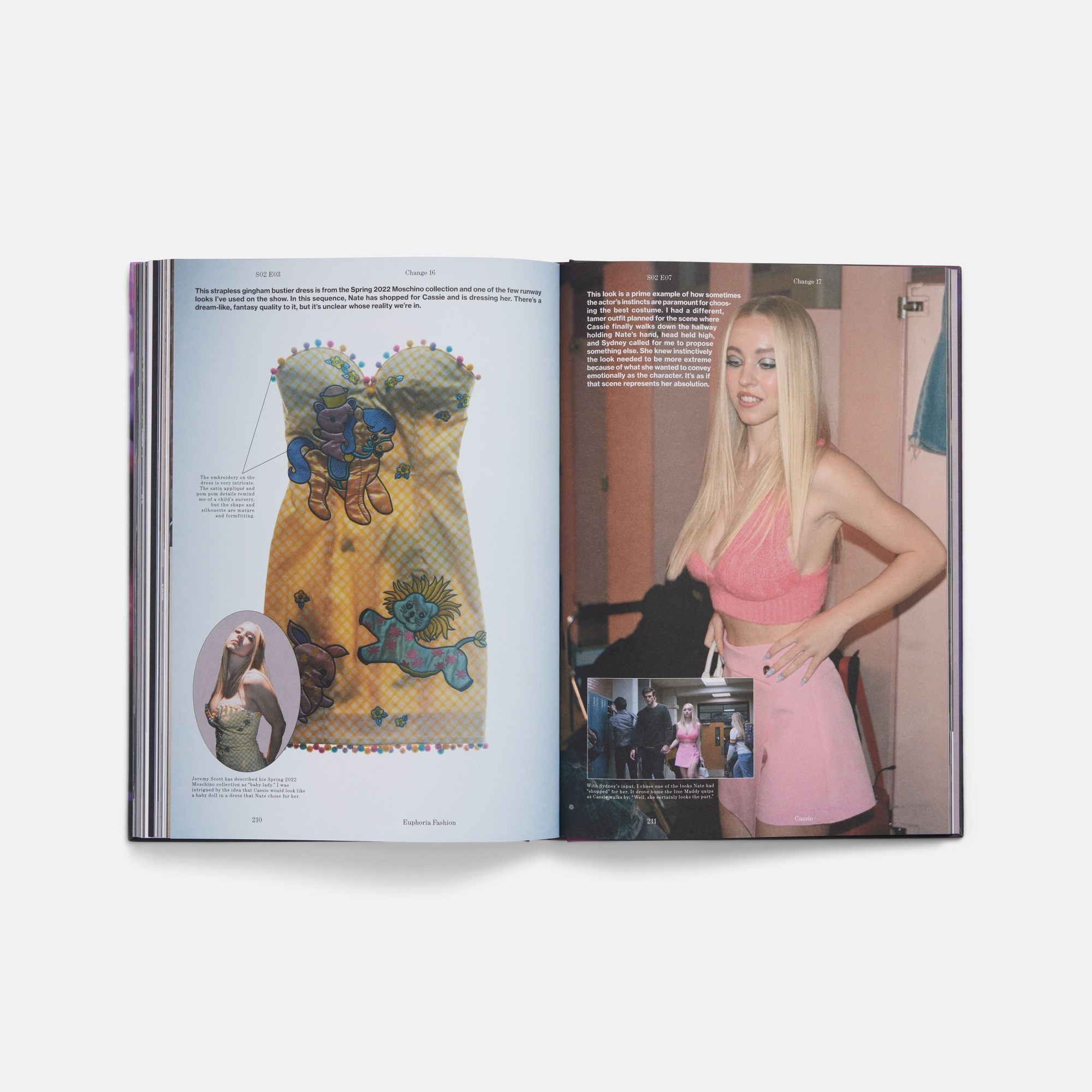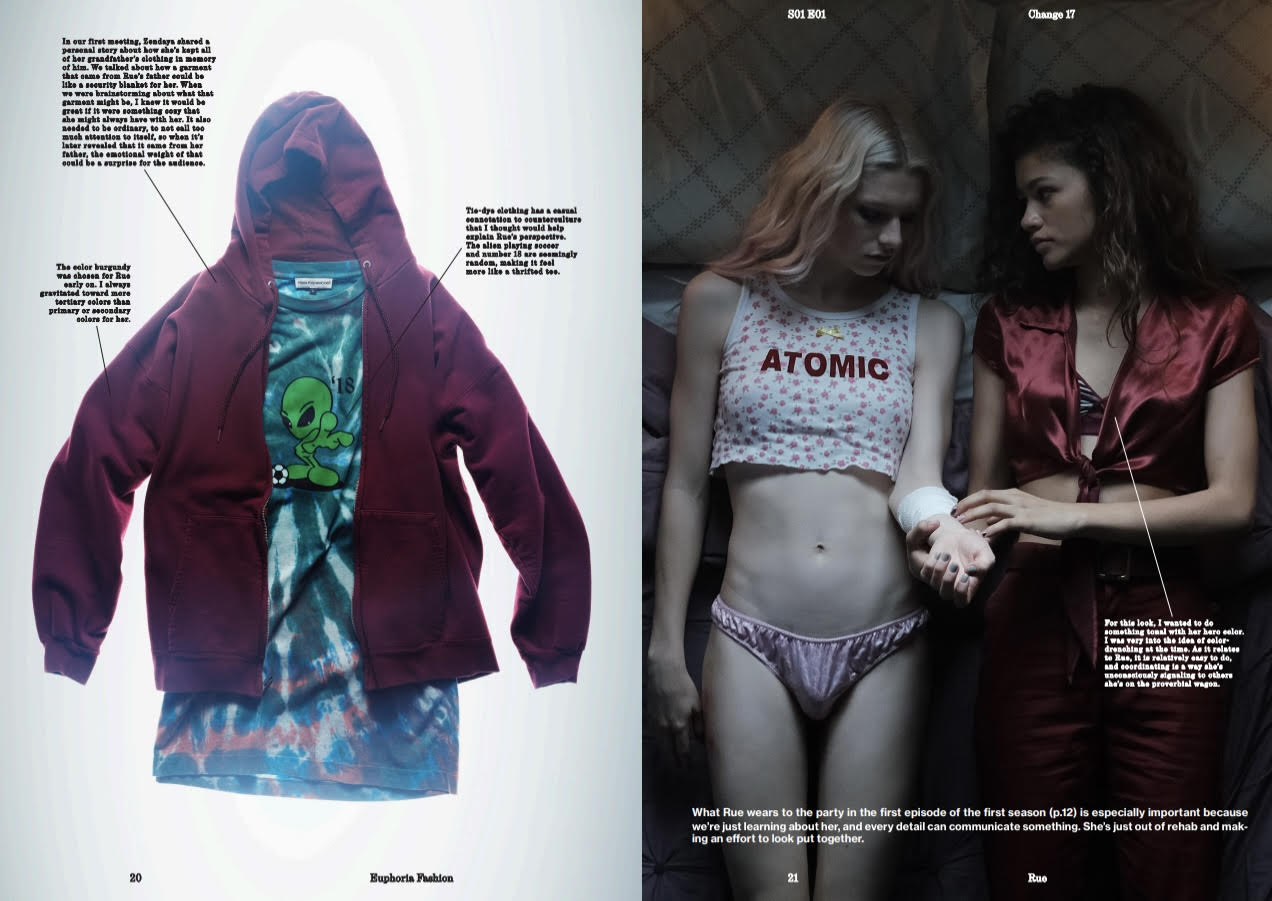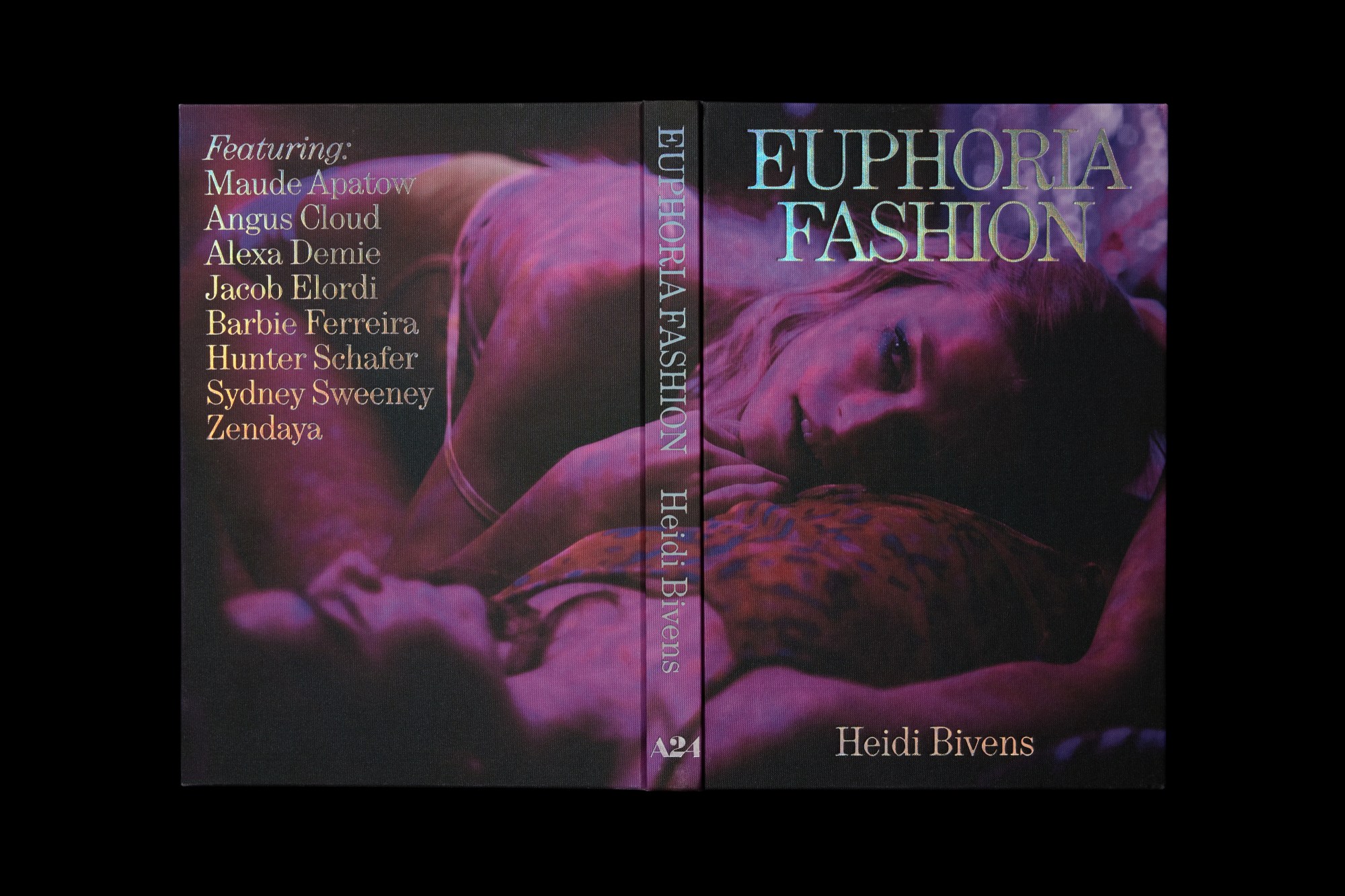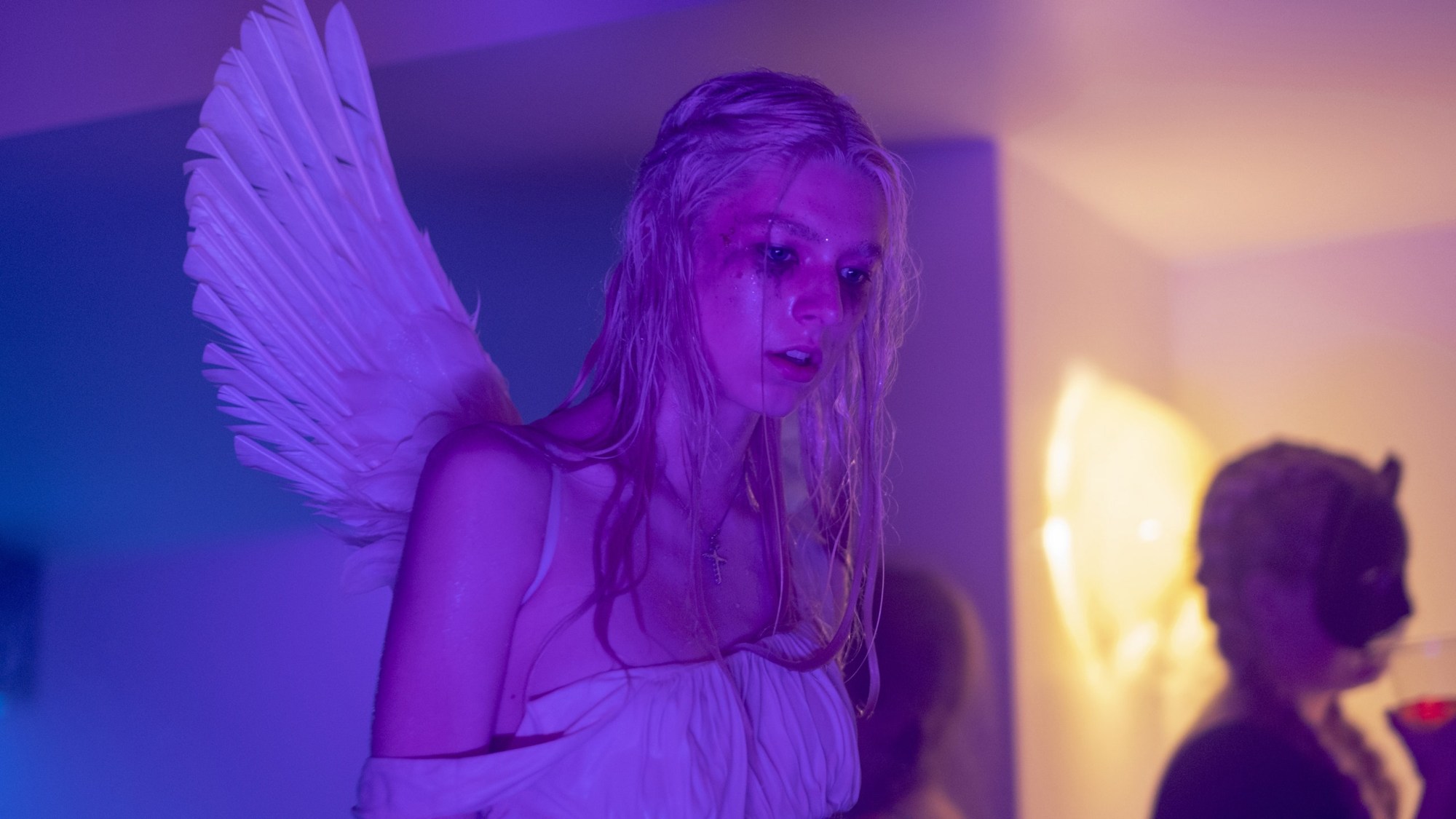The costume designer Heidi Bivens is famous for her work on Euphoria, but she is also known throughout Hollywood as the auteur’s costume designer creating the looks on David Lynch’s Inland Empire and Harmony Korine’s Spring Breakers.
Today, Heidi makes the leap into publishing with the release of Euphoria Fashion, a new book published by A24 and filled with 273 pages of details on the costumes in the hit TV series that mirror the show’s fantastic, instantly recognisable style. The book features new conversations between Heidi and the cast and crew including Zendaya, Hunter Schafer, Alexa Demie, creator Sam Levinson, makeup artist Donni Davy, as well as a foreword by designer Jeremy Scott.
There’s a spread on that I.AM.GIA cut-out set worn by Alexa Demie, fashion breakdowns on notable looks, such as Jules’ Romeo + Juliet Halloween costume (sourced from Poshmark) and Fezco and his RL polo (a personal piece). Here, we publish an extract of what to expect inside, with Heidi going deep on the creative process to Euphoria’s creator Sam Levinson.

Sam Levinson: What I’m most impressed by in your work as an artist and a designer is that you have an auteur’s sensibility. There’s a unified world that you’re creating, even beyond Euphoria. I know you approach it with a sort of “method acting” perspective, in that you really get into the heads of the characters and what the fabrics mean, what the clothes mean, what the backstory is. How does that process actually work?
Heidi Bivens: Most of the time, I’m relying on gut instincts—employing empathy for the characters and a curiosity about the storytelling as well as honoring the vision of the director. In our case, you give me a sense of each character with wardrobe cues, music cues, and details you write into the scripts, and it sends me down a path. I gather what I can and try to turn it into something that feels fresh and isn’t too derivative. I think, in essence, that’s always been the focus of my process—to pull from many different points of inspiration and create something people hopefully haven’t seen before. I’m really interested in your writing process—you’re incredibly prolific. Can you describe your process and your approach to Season Two?
Sam: It’s a bit unusual. I start from a character perspective, and I get really into it, sometimes to the point where I slip into characters without noticing and take on some of their mannerisms or even their thought processes. To me, character is plot. I care more about the characters’ emotional ups and downs and how they’re growing or evolving. With Season Two, I didn’t want to just make another season of television for the sake of it. I’d rather figure out what excites and challenges me and the actors and collaborators I work with, and what we’re yearning for artistically, because I don’t want to lose the passion for it. I want everyone to feel like a new season means a new challenge, and that we’re not allowing it to become some kind of a factory.
Heidi: With Season Two, you embraced this dream world—whether it was memory, flashback, or fantasy. In terms of costumes, navigating that was exciting because of all the layers of meaning for the characters.

Sam: As I began writing Season Two, I noticed that the structure was psychoanalytical in some ways — we’re moving through these different characters’ experiences, psychology, self-loathing, and senses of belonging. I thought, what if we take that a step further and allow it to enter a territory of the unknown, of the dream world? What if we didn’t worry about the logic of a scene? Clarity is the enemy of drama. It’s interesting to enter the characters’ imaginations without any concern for aesthetics, morality, or societal constraints. What exists within them? What’s inside of Cassie’s heart? She wants to be Nate’s girl. She wants to be this doll that he obsesses over. Whether that’s appropriate by societal standards doesn’t matter — that’s what she wishes for. Same thing with Rue and Jules and the Lover’s Montage. It became an interesting narrative angle that lives just below the surface. While I was writing it, I would try to lose my mind. I would almost free-associate from one image to another. I wasn’t thinking too much about structure or if it made sense. I abandoned those normal writing rules and opened up space for the images, visuals, and the heart of the piece to come alive on its own and go where it goes.
Heidi: In doing that, you gave me full permission to do the same.
Sam:: All of those outfits allow Cassie to be in this dream world of Nate’s. We’re tapping into her with those pastels and the Tiffany necklace. There’s something deeply funny about it and also beautiful and tragic. When those three things come together, it’s quite exciting. Same thing with Lexi’s journey throughout that whole play.
Heidi: I love how layered the storytelling of the dream world is. After reading the script, I asked about your intention: was a scene actually set on the stage, or is it in Lexi’s memory of something that happened? What was reality? What was a flashback? Do the costumes depend on who’s having the flashback, or is it more ambiguous?

Sam: Especially when we’re seeing a memory we’ve already seen from another character’s perspective.
Heidi: For the special episodes, you confirmed that in their separate fantasies Rue and Jules would be wearing the same things, which made total sense to me in that it didn’t make sense. That’s when you’re respecting your audience’s intelligence, giving them the benefit of the doubt and letting them discover something. Not everything has to be so expository. Like you said: clarity is the enemy of drama. My favorite part of costume designing the show was getting in the head of a character and figuring out their memory of what someone wore, or sometimes the memory of another character’s retelling of what someone wore. For example, in the first episode of Season Two with Fezco’s Grandma Kitty: it’s Rue’s recollection of Fezco telling that story, so Grandma Kitty can be larger than life in Rue’s mind — it didn’t matter what she really looked like. And that’s where the fun begins.
Sam: Can you talk about the process of making Kitty’s pantsuit for the opening of that episode?
Heidi: It was originally scripted to be set in Vegas, and I immediately thought of the famous Nudie suits worn by celebrities like Elvis Presley and country music stars at the Grand Ole Opry. Nudie’s Rodeo Tailors were really popular with a lot of recording artists during the ’60s and ’70s. I didn’t want to do their popular rhinestone suits — that’s been done a million times. But my friend, Lisa Eisner, who has incredible style, had worn an original blue Nathan Turk look to an event a few years back that I was really inspired by. I took this idea of a bright blue suit, but instead of rhinestones I wanted to do embroidery. And instead of contrast color embroidery, which would normally be used on a rodeo suit like that, I chose tone-on-tone blue metallic thread. I used the original elements of the first inspiration and then something that felt more subtle.

Sam: Are you often looking at people you know in real life or people you see on the street for costume ideas?
Heidi: I believe one of the best ways to build style for contemporary characters is to take inspiration from real people. Then there’s something grounded in reality that I can believe in. All the while, I’m looking for the humanity in the characters; whether they’re the most despicable or the most lovable, they all have a right to exist in a story. With Euphoria, you gave me permission to tap into a fantasy world outside of reality, and the merging of these two is what has helped the show to have a unique look of its own. I’m curious about the way you and Marcell Rév, the cinematographer, bridge these worlds. You two often collaborate in this kind of “mind meld” way, where a scene can often become something more through the process of blocking and figuring out how you want to shoot it. Do you and Marcell develop the look of the show over the course of shooting it, or do you know from the beginning how you’re going to tell the story visually?
Sam: We always set rules for ourselves, so even though it feels like we’re doing whatever we want, there are very hard-and-fast rules. For instance, in Season Two, we wanted to eliminate some of the more frenetic camera movement that we did in Season One. We don’t do unmotivated pans and we try to keep almost everything limited to as few shots as possible. We also wanted to shoot it on film, particularly Ektachrome, and at night, which puts very big restrictions on where we can move the camera because the exposure won’t come out. Those constraints force us to figure out how to tell the story and shoot a scene in, say, two shots instead of six. Sometimes that makes it really hard to shoot a more conventional scene. But we also have to be open to what’s happening within the actor, on the set, in the production design, in the costumes. We want to be open to all of the unpredictability of it.
Heidi: Thinking about Season Three, do you imagine the look will continue to evolve?
Sam: A hundred percent, or else there’s no reason to do it. I want it to have a certain scope, so that might mean less soundstage work and more practical locations. I also want to play with different things in terms of camera and storytelling. But the key is to find ways to challenge ourselves.That’s what makes Euphoria such a rewarding show — it’s fucking brutal to make, but as soon as there’s no challenge, it’s time to give it up.
Euphoria Fashion by Heidi Bivens is released today by A24.


